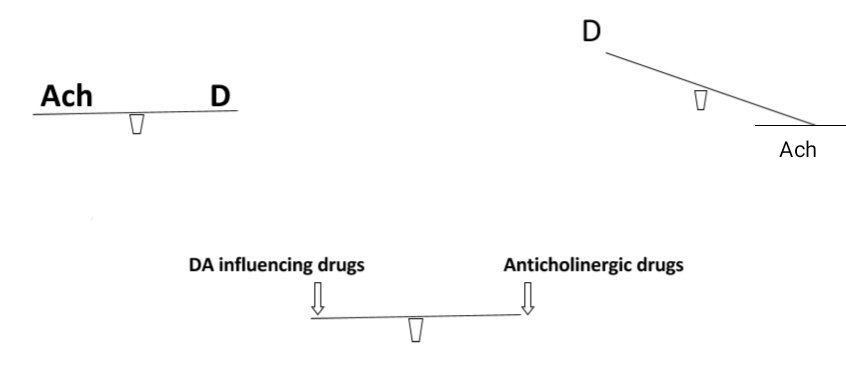Hi everyone 🙂
• In Parkinson’s disease there is destruction of dopamine containing neurons resulting in dopamine deficiency
• So there is imbalance between inhibitory dopaminergic neuron and excitatory cholinergic system
• Imagine this as a seesaw in which there is balance between Ach and Dopamine . In parkinsonism this balance is lost due to dopamine deficiency

Classification
1.Drugs affecting dopaminergic system
Mnemonic-LA CBSE
a)Dopamine precursor-Levodopa
b)NMDA receptor antagonist-Amantadine
c)Peripheral decarboxylase inhibitor-Carbidopa,benserazide
d)Dopaminergic agonists-Bromocriptine,Ropinirole
e)MAO-B inhibitor-Selegiline
f)COMT inhibitor-Entacapone,Tolcapone
2.Drugs affecting cholinergic system-
Mnemonic-BP
a)Central anticholinergic-Benzhexol,Biperiden
b)Antihistaminics-Promethazine

A )Levodopa
• It is a prodrug
• It is used as dopamine cannot cross Blood brain barrier
• Levo dopa crosses BBB and is converted into dopamine by Dopa decarboxylase
• Dopamine produced then interacts with D2 receptors in basal ganglia and produce anti Parkinson effects
Actions
1)CNS
Hypokinesia, rigidity and tremors are resolved first
Then posture, gait, handwriting, speech are normalized
2) CVS
Tachycardia(action on beta adrenergic receptors) and postural hypotension
3) CTZ
Nausea and vomiting (as dopaminergic receptors are present near CTZ)
4) Endocrine
Growth hormone and prolactin
Pharmacokinetics
• Rapidly absorbed on oral administration
• Amino acids may delay its absorption ,hence given 30-60 minutes before the meal
• Its Active transport in brain may be inhibited by dietary amino acids
• Metabolites excreted in urine
Adverse effects-
1) GIT-Nausea, Vomiting, Anorexia
2) CVS-Tachycardia, Postural hypotension
3) Dyskinesia- Tics, tremors, choreoathetoid movements
4) Alteration in taste sensation
5) Behavioral- Anxiety, depression, tremor, mania, mental confusion
6) Fluctuations- after 2-5 years On-Off effect is seen
B ) Peripheral decarboxylase inhibitor-Carbidopa and benserazide
• As the name suggests they inhibit peripheral decarboxylation of levo dopa and does not cross BBB
• Benefits-
• Dose of levodopa is reduced to 1/4th
• Nausea and vomiting are reduced
• Cardiac complications minimized
• Reduces on-off phenomena due to sustained release
• Plasma half life of levodopa Is prolonged
• Better patient compliance
C ) Dopaminergic agonist – Bromocriptine
• It is an ergot derivative
• Has agonistic action at D2 and partial agonistic action at D1
Adverse effects
• Vomiting, hallucinations, hypotension, nasal stuffiness, cardiac arrythmias, dyskinesias
Ropinirole and pramipexole
• Non ergot hence ergot related side effects are not seen
• Indicated in restless leg syndrome
D ) COMT inhibitors- Tolcapone and entacapone
• Act as adjuvants to levodopa-carbidopa for advanced Parkinson’s disease
• Reversible COMT inhibitors
• They inhibit peripheral metabolism of l-dopa to 3-O-methyldopa and hence increase half life and bioavailability in CNS
• Tolcapone has both central and peripheral actions whereas entacapone acts only peripherally.
Adverse effects-
Dyskinesia, nausea, hypotension, hallucination
Tolcapone rarely causes fulminant hepatitis
E )MAO-B inhibitors- Selegiline and rasagiline
• Selectively and irreversibly inhibit MAO-B enzyme in the brain
• Do not inhibit MAO-B in the periphery
• Retard the metabolism of dopamine in the brain and prevent formation of toxic metabolites
• hence have neuroprotective effect in idiopathic pd
• reduce on-off effect
• prolong effect of levo dopa
• rasagiline-it is more potent and longer acting. hence, single dose required.
Adverse effects-
Metabolites of selegiline cause side effects like nausea, vomiting, anxiety, insomnia
F ) NMDA receptor antagonist –Amantadine
• It is an antiviral drug used for treatment and prophylaxis of influenza
• It has antagonistic action on NMDA receptors i.e. decreases glutamate neurotransmission in basal ganglia
• It is only used for mild PD
• Its therapeutic activity can be increased by combining with l-dopa
Adverse effects-
Insomnia, restlessness, nightmares, anticholinergic effects, livedo reticularis
G) Central anticholinergics
• Benzhexol is considered as DOC in drug induced parkinsonism
• Acts by reducing increased cholinergic activity in striatum
• Relieves tremor and rigidity with little effect on hypokinesia
• Are less effective than levodopa but are cheap and more tolerated
Adverse effect-
Dry mouth, constipation, blurring of vision, drowsiness, urinary retention
Thank you!
-Anuja Mandavkar, GMC Latur
